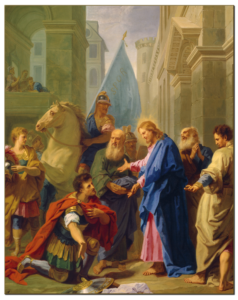Object of the Month: April 2019
Christ with the Roman Centurion
Oil on canvas, c. 1712, Signed with initials, lower left: J.J.
Jean Baptiste Jouvenet
French, 1649–1717
 An anonymous but astute artist once said, “Creativity lives at the mercy of self-discipline; without self-discipline, creativity is just a flight of fancy.” Perhaps no one better illustrates the truth of this aphorism than painter Jean Baptiste Jouvenet. Taking in the visual textures, architectural detail, and life-like figures in his Christ with the Roman Centurion, it’s hard to believe that during the creation of the work Jouvenet’s painting hand (right hand) was in the final stage of paralysis. He began losing control of his right hand in the last decade of his life. Undeterred he trained himself to paint with his left hand and continued to work!
An anonymous but astute artist once said, “Creativity lives at the mercy of self-discipline; without self-discipline, creativity is just a flight of fancy.” Perhaps no one better illustrates the truth of this aphorism than painter Jean Baptiste Jouvenet. Taking in the visual textures, architectural detail, and life-like figures in his Christ with the Roman Centurion, it’s hard to believe that during the creation of the work Jouvenet’s painting hand (right hand) was in the final stage of paralysis. He began losing control of his right hand in the last decade of his life. Undeterred he trained himself to paint with his left hand and continued to work!
Jouvenet was born in Rouen, a port city on the river Seine whose skyline is still dominated by Gothic cathedral spires. He entered Charles Le Brun’s studio at twelve (1661) and a year later was admitted to the Rouen painters’ guild. Throughout his teen years he helped Le Brun, King Louis XIV’s chief arts leader, with designs and decorations for some of France’s most opulent dwellings, including the Salon de Mars at Versailles.
Jouvenet would go on to become the greatest French religious painter of his generation. Christ and the Roman Centurion highlights some of the reasons why. The work combines the opulent technique of his early training with the subtle realism of his later work. The result is a tempered emotionalism that actually enriches the dramatic power of the scene. The smaller size also indicates that it is a modello for a larger altarpiece Jouvenet painted for the church of the Récollets at Versailles. Artists like Jouvenet presented these smaller, meticulously painted versions to their wealthy patrons for final approval before completing the commissioned masterpiece.
At the end of his life Jouvenet would use his “new” painting hand to complete a group of eight paintings for the Cathedral of Notre-Dame in Paris. Like M&G’s Christ with the Roman Centurion it is signed and dated. For the cathedral, however, he departs from using his traditional initials of J.J., choosing instead to sign and date the work as follows: J. Jouvenet dextra paralyticus sinistra fecit 1716 (J. Jouvenet right palsy uses left, 1716). To read more about this grouping and to see the signature visit Notre-Dame de Paris. (The signature is clearly visible on the step in The Visitation Painting at the end of the article.)
Donnalynn Hess, Director of Education
Published in 2019